Archive for März, 2010
CHRIST FELLOWSHIP MINISTRIES PAKISTAN

> CHRIST FELLOWSHIP PAKISTAN <
> Oxford Journal: Trad. Medicine in Pakistan <
> UNANI MEDICINE < > SIDDHA MEDICINE <
> UNANI Medicine with Reference to Pakistan and India <
Pakistan (Urdu: پاکِستان), officially the Islamic Republic of Pakistan, is a country in South Asia. It has a 1,046 kilometres (650 mi) coastline along the Arabian Sea and Gulf of Oman in the south and is bordered by Afghanistan and Iran in the west, India in the east and China in the far northeast. Tajikistan also lies very close to Pakistan but is separated by the narrow Wakhan Corridor. Thus, it occupies a crossroads position between South Asia, Central Asia and the Middle East.
The region forming modern Pakistan was at the heart of the ancient Indus Valley Civilisation and then later was the recipient of Vedic, Persian, Indo-Greek, Turco-Mongol, Islamic and Sikh cultures. The area has witnessed invasions and/or settlements by the Indo-Aryans, Persians, Greeks, Arabs, Turks, Afghans, Mongols and the British. Read More: > HERE <
Dear Friends in Christ, Greetings From Pakistan!
My name is Sabeeha Kiren. I am Finance Secretly and am working for Christian women, girls and widow in the Islamic Republic of Pakistan from the platform of Christ Fellowship Ministries, and am working for the Ministry as a sharing the Word of God with women, girls and widow how to pray and Praise Him, with them. We are Family of God.
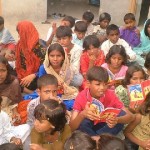
Christ Fellowship Ministries is working for the Christian Street Children who do not have support from the family because of poverty and those who are forced to child labor, begging, drugs, gambling and other criminal activities because of not being tended with love and care. The Christian people do not get equal rights as the Muslims possess. God bless you and keep you.
Yours Sister in Christ, Miss Sabeeha Saddique
Christ Fellowship Ministries
JAIN TRADTION, MAHAVIR JAYANTI IN INDIA

> Sri Shri Mahavir Jain temple, Plan a Yatra <
> 2010 JAINA Convention : Live and HELP Live! <
In Jainism, Mahavir Janma Kalyanak is the most important religious holiday. It celebrates the birth of Mahavira, the last Tirthankara. On Mahavir Jayanthi, Jain temples are decorated with flags. In the morning the idol of Mahavira is given a ceremonial bath called the ‚abhishek‘. Lord Mahavira is an ideal in Jainism who taught the world the essence of life. He taught all of us the right way of living the life.The day of his birth is celebrated in a massive procession around the cities. Lord Mahavir was a great teacher who taught mankind the true path of happiness. His teachings on complete nonviolence and the importance of austerity showed the path to achieving salvation and spirituality. Read More: > HERE <
In Jainism, a Tirthankar (तीर्थंकर: „Fordmaker“; also Tirthankara or Jina) is a human being who achieves enlightenment (perfect knowledge) through asceticism and who then becomes a role-model teacher for those seeking spiritual guidance. A Tirthankar is a special sort of arhat, a person who has totally conquered base sensibilities such as anger, pride, deceit, or desire.
A Tirthankar is so called because he is the founder of a „Tirth“ (literally, ‚ford‘), a Jain community which acts as a „ford“ across the „river of human misery“.
Yaksha (Sanskrit यक्ष, yakṣa , ञक्ख yakkha in PÄ�li ) is the name of a broad class of nature-spirits, usually benevolent, who are caretakers of the natural treasures hidden in the earth and tree roots.They appear in Hindu, Jain and Buddhist mythology. The feminine form of the word is yakṣÄ� (यक्सि) or yakṣiṇÄ� (यक्सिनि)(PÄ�li: yakkhÄ� (यक्खि) or yakkhinÄ� (ञक्खिनि)
The Jina’s are worthy of worship because they are the ultimate victor oner the phenomenal fetters, conquired over the all desire of human being.
Jinas are twenty four in number whom we call > ‘Tirthankar’ < and each of them is served by > Yaksha < and >Yakshini < , includes 64 yakshinis (yogini), fifty two viras, sixteen vidya Devis, ten dikpalakas and nine planets. Jina is subordinated by all like Yaksha, Yakshini, Ashta Dikpalakas, Planets and the Jina is above all. Jina’s are countless but four of them are especially worshipped not only in India but all over the world – They are –
- Adinath (The first in the present time)
- Neminath (The twenty Second)
- Parsavanath (The twenty Third)
- Mahavira (The twenty fourth – the last)
- Jina’s are ‘gods above gods’, Everybody is divinities of Jina’s. Jina’s are known by its symbol by whom the shrine is made.
The image of Jina should be nude, youthful, handsome, transquil, decorated by the Sri-vatsa embelom on the chest, arms must reach the knee, tip of the middle finger of the hand touching the knee, two armed, two eyed, no ornament on any part of the body, nor any cloth anywhere in the body, Jina must neither be represented as an old man nor as a boy, always in prime of youth, peaceful, devoid of hair and nails even no hair on the armpit or any other part of the body, not even moustache line, the height of the Jina must be equal to 108 fingers (Anguls). The plum line must pass through precisely centre of the body of the image. The Jina will be either standing or seated no bend anywhere in the body. Seated pose will be lotus posture, legs are crossed, hands are brought together, the mood will be in the complete renunciation, engaged in penance or in Yoga posture. The expression Jina to conquest over the inner enemies like passion and hatred. Wherethese Teerthankara’s are duly installed in the temple, theyare called ‘Sthapana Jinas’.
Today the 28th April is Mahavir Jayanti which is celebrated with great pomp and show in all over India& abroad..
Mahavir Jayanti which is celebrated with great pomp on Parasnath hill in Bihar, a holy land for the jains. In Rajasthan (Jaipur) after special Puja, a procession is taken out.
Annual lakhi Mela is held at Mahavir Pilgrimage in Sehstravid (on the bank of river Gambhira) railway station, Mahavirji, 140 Km from Jaipur, on 13 Chetr shukl to 2 Baisakh Ditya, for five days. Million of pilgrims visit this place to pay their reverence to Digambar Jain Sri Mahavirji, the 24th Jain Tirthankar. On the last day of the fair, rath yatra (procession on a chariot) is taken out from huge, magnificent, profusely decorated with oil paintings and architectural beautiful temple. Meena trigal men and women, in colourful dresses, form the main part of the procession and proceed in front of the chariot, singing, dancing, jumping and enjoying. The fair is attended by people from all over the country irrespective of caste or creed.
Mahavir Jayanti, a day of gazette holiday, is observed all over India in all Jain temples by Jain devotees.
NALANDA about 55 miles south east of Patna, was a Buddhist center of learning from the 5th century CE to the 12th century.IT WAS BUILT BY KING HARSHWARDHAN IN HIS TIME….
The JAIN Tirthankara Mahavira attained Moksha at Pavapuri, which is located in Nalanda (also according to one sect of Jainism he was born in the nearby village called Kundalpur The Gautama Buddha is believed to have visited Nalanda and given sermons near „the Mango Grove of Pavarika“. SÄ�riputta, the right hand disciple of the Buddha, was born and died in Nalanda. Asoka is said to have built a temple there. According to Tibetan sources, Nagarjuna taught there.[citation needed] However, historical studies indicate that the university was established c. 450 CE.
NALANDA was one of the first residential universities, i.e. it had dorms. During its days it was a flourishing residential university with over 10,000 students and 1500 teachers. The university was marked by a lofty wall and one gate. The library was located in a nine storied building. The subjects taught at Nalanda University covered every field of learning. The Tang Dynasty Chinese pilgrim Xuanzang left detailed accounts of the university in the 7th century.
A vast amount of what is considered to be Tibetan Buddhism (Vajrayana) actually stems from the late (9th-12th century) Nalanda teachers and traditions. Other forms of Buddhism, like the Mahayana followed in Vietnam, China, Korea and Japan, found their genesis within the walls of the ancient university. Theravada, the other main school of Buddhism, followed in Sri Lanka, Myanmar, Thailand, Cambodia, and elsewhere, and later the mystic Theravada schools also developed here.
In 1193, the Nalanda University complex was sacked by Turkic Muslim invaders under Bakhtiyar Khalji; this event is seen as a milestone in the decline of Buddhism in India. It is said that Khalji asked if there was a copy of the Koran at Nalanda before he sacked it. When the Tibetan translator Chag Lotsawa visited them in 1235, he found them damaged and looted, but still functioning with a small number of monks. The destruction of the universities at Nalanda, as well as the destruction of many temples and monasteries throughout northern India which housed centers of learning, is considered by many historians to be responsible for the sudden demise of ancient Indian scientific thought in mathematics, astronomy, alchemy, and anatomy.
Fortified Sena monastaries along the main route of the invasion were destroyed, and being off the main route both Nalanda and Bodh Gaya survived. Many instituions off the main route such as the Jagaddala Monastery in northern Bengal were untouched and flourishing. More information here:-
- www.nalanda.nitc.ac.in/about/nalandaheritage.html
- http://en.wikipedia.org/wiki/Nalanda
- Archaeological geography of the Ganga Plain: the lower and the middle Ganga <
- Article: MAHAVIR JAYANTI IN INDIA
- by Prof. (Dr.) Chitralekha Singh
- Mangalayatan University
- www.artistchitralekha.com
AJAM TULKU RINPOCHE IN BERLIN
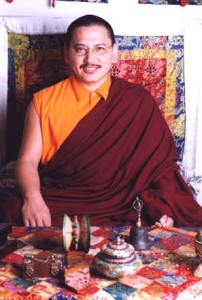
> PALYUL LING < > NAMDROLING <
Mahayana (Sanskrit: महायान, mahÄ�yÄ�na literally ‚Great Vehicle‘) is one of the two main existing branches of Buddhism and a term for classification of Buddhist philosophies and practice. It was founded in India. The name „MahÄ�yÄ�na“ is used in three main senses.
Although the MahÄ�yÄ�na movement traces its origin to Gautama Buddha, scholars believe that it originated in India in the 1st century CE,or the 1st century BCE.Scholars hold that MahÄ�yÄ�na only became a mainstream movement in India in the fifth century CE, since that is when MahÄ�yÄ�nist inscriptions started to appear in epigraphic records in India.Before the 11th century CE (while MahÄ�yÄ�na was still present in India), the MahÄ�yÄ�na sūtras were still in the process of being revised. Thus, several different versions may have survived of the same sūtra. These different versions are invaluable to scholars attempting to reconstruct the history of MahÄ�yÄ�na. Read More: >HERE <
BUDDHISMUS IN BERLIN in Kooperation mit dem TIBETHAUS BERLIN
AJAM TULKU RINPOCHE in Berlin – Zur Person: Tulku Ajam ist die Wiedergeburt des jüngeren Bruders von S. H. Drubwang Pema Norbu Rinpoche (Penor Rinpoche) und hat bis zu seinem 15. Lebensjahr in der Schweiz gelebt. Von Penor Rinpoche als eine Reinkarnation bestätigt, hat er seine intensiven Studien an der Klosteruniversität von Namdröl Ling in Südindien. Rinpoche lehrt in Deutsch!
2. April: Die Payul-Nyingma-Tradition (19-21h)
Von den vier Hauptrichtungen des Mahayana- Buddhismus in Tibet gehört die Nyingma-Tradition zu den ältesten Überlieferungen und lehrt die Anwendung des Dzogchen – i.e. „Die Große Vollkommenheit“, respektive die Lehre von der Verwirklichung der „Reinen Natur des Geistes“. Diese Überlieferung des Dzogchen reicht bis auf die Ursprünge des Buddhismus in Indien zurück und wurde zu Beginn des 9. Jahrhunderts n. Chr. insbesondere durch Guru Padmasambhava, nach Tibet gebracht.
Die Palyül-Tradition ist eine der Schulen der Nyingma-Tradition und zählt neben Kathok, Mindroling, Dzogchen, Shechen und Dorje Drak zu den sogenannten „Sechs großen Sitzen“ der Nyingma. Sie hat ihren Namen vom Palyül-Kloster im gleichnamigen Bezirk Palyül in Karze (tib.: dkar mdze), dem heutigen Sichuan, zurück. Der letzte Linienhalter der Payül Tradition war S. H. Drubwang Pema Norbu Rinpoche (Penor Rinpoche), Abt des Klosters Namdröl Ling in Südindien mit etwa 5000 Mönchen und Nonnen und der Lehrer von Ajam Tulku Rinpoche.
3.-4. April: Erklärung zu einem kurzen Namchö-Terma (Schatztext von Padmasambhava) über Meditiation (10-13h und 14h30-18h (Sonntag nur bis 16h30)
Tulku Ajam wird einen kurzen „Namchö- Schatztext“ (tib. terma) aus einer Sammlung von Unterweisungen von Padmasambhawa, der von den Tibetern liebevoll „Guru Rinpoche“ (wörtlich: Kostbarer Meister) genannt und als „Zweiter Buddha“ verehrt wird, kommentieren. Der Text enthält mündliche Anleitungen zur Meditation, die dieser im 9. Jahrhundert u. Z. während seines Aufenthalts in Tibet gegeben hat. Die essenziellen Unterweisungen wurden von seiner Schülerin Yesche Tsogyal in der verschlüsselten Geheimsprache der Dakinis dokumentiert und als kostbare Termas verborgen, damit sie zum späteren Zeitpunkt von den Tertöns, den (Wieder-) Entdeckern der Schatztexte, offenbart werden können. Guru Rinpoche hat die Namen der zahlreichen Tertöns und den Zeitpunkt ihres Auftretens prophezeit.
Dieser Text wurde vom großen Tertön Mingyur Dorje (1645-1667) entdeckt. Es heißt, dass die in Form von Schriften oder Visionen entdeckten Kernunterweisungen den Bedürfnissen der jeweiligen Zeit entsprechen und den Praktizierenden zukünftiger Generationen dienen.
Veranstaltungsort: Bodhicharya, Kinzigstrasse 25-29, 10247 Berlin
Kurssprache: Rinpoche wird in seiner Muttersprache, Deutsch lehren.
- Die Mittleren Stufen der Meditation <
- INTRO OF THE FIVE TRADITIONS <
- Techok Namdrol Ling Monastery, Four Noble Truths <
- Meet Buddhismus in Berlin, studies, friends at fb <
- Meet If your real interested in Buddhims or Buddhist at fb <
BUDDHISM: THERAVADA AND HINAYANA

Theravada (PÄ�li: थेरवाद theravÄ�da, Sanskrit: स्थविरवाद sthaviravÄ�da); literally, „the Teaching of the Elders“ or „the Ancient Teaching“, is the oldest surviving Buddhist school. It was founded in India. It is relatively conservative, and generally closest to early Buddhism, and for many centuries has been the predominant religion of Sri Lanka (about 70% of the population ) and most of continental Southeast Asia (CAMBODIA, LAOS, BURMA, THAILAND). Theravada is also practiced by minorities in parts of southwest CHINA (by the SHAN and TAI ethnic groups), Vietnam (by the KHMER Krom), Bangladesh (by the ethnic groups of Baruas, Chakma, and Magh), Malaysia and Indonesia, while recently gaining popularity in Singapore and the Western World. Today Theravada Buddhists number over 100 million worldwide, and in recent decades Theravada has begun to take root in the West and in the Buddhist revival in India. Read More: > HERE <
HÄ�nayÄ�na (हीनयान) is a Sanskrit and PÄ�li term literally meaning: „the low vehicle“, „the inferior vehicle“, or „the deficient vehicle“. The term appeared around the 1st or 2nd century CE. Its use in scholarly publications is controversial.There are differing views on the use and meaning of the term, both among scholars and within Buddhism. Read More: > HERE <
THERAVADA AND HINAYANA – As mentioned above, the Theravada tradition is based on the set of teachings decided by the Third Council to contain the teachings of the Buddha.
Shri Lanka has played a central role in preserving the Theravada scriptures and practices. After the Third Council, the Tripitaka collection of sutras were taken to Shri Lanka. Most of these were originally in the Pali language, but some were compiled in other languages. Through the centuries however, all teachings were translated into Pali (around 35 BCE). Initially, most ordained Sangha were known as parivrajahas (wanderers). They would assemble during the rainy season when travelling became problematic. Gradually, buildings were donated and the Sangha became more static. Just a century after the Buddha passed away, monasteries became the main mechanism for preservation of the teachings. Also extra monastic rules were introduced. Only during one short period in history Buddhism was banned in Shri Lanka, but it was later restored with teachings from Thailand which in turn had originated in Shri Lanka. The main countries where the Theravada tradition is currently alive and well in Shri Lanka, Thailand, Burma, Cambodia and Laos.
The teachings on the Four Noble Truths and meditation form the basis of Theravada practice. – The term Hinayana (smaller Vehicle) appeared only much later, around the first century CE, when teachings of a different nature appeared which were called Mahayana (greater Vehicle).
In India, non-Mahayana or Hinayana sects developed independent from the form of Buddhism existing in Sri Lanka. Today, there is no Hinayana tradition in existence anywhere, although Theravada could be called the tradition most like Hinayana. The ultimate goal of the Theravadin and other non-Mahayana practice is to attain the state of an Arhat, as Buddhahood is considered practically unachievable for nearly everyone within this aeon.
Although helping other sentient beings is accepted as an important Buddhist practice, the main motivation for following the spiritual path is to achieve liberation for oneself – Nirvana.
Due to the negative connotation of the term Hinayana, the World Fellowship of Buddhists decided that the term Hinayana should be dropped to refer to Buddhism existing today, and the term Theravada should be applied, also because the term Hinayana has a negative connotation.
MAHAYANA – The Mahayana appears to have developed between the 1st Century BC to the 1st Century CE. About the 2nd Century CE Mahayana became clearly defined. Master Nagarjuna developed the Mahayana philosophy of Sunyata (emptiness) and proved that everything is ‚Void‘ (not only the self) in a small text called Madhyamika-karika. After the 1st Century CE., the Mahayanists took a definite stand and only then the terms of Mahayana and Hinayana were introduced.
Around the first century CE, teachings of a different style appeared. The terms Mahayana and Hinayana appeared in the Saddharma Pundarika Sutra or the Sutra of the Lotus of the Good Law. Of great influence to the development of the Mahayana was Master Nagarjuna (2nd Century CE) who is known for his profound teachings on the philosophy of emptiness. About the 4th Century CE, the Masters Asanga and Vasubandhu wrote enormous amount of works on Mahayana. The Mahayana teachings were mainly written down in Sanskrit, and are now called the Mahayana Sutras.
A clear division arose between the schools following the traditional teachings and Mahayana. Although the main philosophical differences may be small, they have profound consequences for the practices involved.
The Mahayana philosophy is based on the older tradition and fully accepts these teachings, but not all traditional interpretations. One of the most important aspects is for example the traditional interpretation that Buddhahood can be achieved only by very few people. The Mahayana teaches instead that every sentient being (being with a mind) can become a Buddha, the only thing preventing our full enlightenment is the failure to improve one’s own actions and state of mind. The Mahayana tradition claims that all their sutras have been taught directly by Shakyamuni Buddha or have at least been inspired by the Buddha.
The main Mahayana motivation is to lead all sentient beings to enlightenment. Liberation from cyclic existence (Nirvana) and Buddhahood for oneself are regarded simply as fortunate by-products of one’s efforts to help all beings. In fact, the only possible motivation with which one can become a Buddha is the altruistic wish to lead all sentient beings away from suffering.
This motivation is reflected in taking an additional set of vows, known as Bodhisattva vows on top of taking Refuge. The main vow is to free all sentient beings from suffering. These vows are not taken for this life only, but for all future lives as well, until this goal is achieved. The main practices of a Mahayanist are summarised in the 6 perfections: the perfection of giving, ethics, patience, joyous effort, concentration and wisdom.
The Mahayana tradition mainly developed in North India, and spread further North into China and Tibet. In China, Buddhist philosophy and practice was often mixed with Taoist and Confucian aspects. Via China, Mahayana Buddhism also spread to other countries like Korea, Vietnam, Cambodia, Laos and Japan. Also, in China the Ch’an tradition evolved, which was introduced into Japan, and there developed into Zen. Also, the very popular Pure Land Buddhism developed, which focuses on being reborn in the Pure Land of Amitabha, mainly through recitation of Amitabha Buddha’s name. Pure Land Buddhism is known as Jodo in Japan.
In contrast to the current very clear division between Theravada and Mahayana schools, it must be noted that for many centuries, monasteries in India were filled with monks of both traditions. It was considered a very personal decision to choose for individual liberation or Buddhahood. The monastic and ordination rules are virtually the same, and the teachings overlap to a great extent. See for example this important text from the World Buddhist Sangha Council convened by Theravadins in Sri Lanka in 1966.
TANTRAYANA – Around the 6th. century AD, within the Mahayana tradition the tantras or tantric texts emerged. Based firmly on the Hinayana and Mahayana tradition, the actual philosophy differs only slightly from the Mahayana, but the practices can be quite different.
Prior to engaging in tantric practices, a proper understanding of the Hinayana and Mahayana philosophy is considered essential. Only then should one obtain initiation or permission from a qualified tantric master to do a specific tantric practice.
Tantric practices are psychologically very profound techniques to quickly achieve Buddhahood. This is considered important, not for oneself, but because as a Buddha one has the best achievable qualities to help others.The motivation is: ‚the faster I can achieve Buddhahood, the sooner I can be of maximum benefit to others‘.
Depending on the class of tantra, extra vows may need to be taken on top of the Refuge and Bodhisattva vows. Also, specific commitments may be required like doing a specific retreat, daily recitation of mantras or a daily meditation practice. (For more details see the page on Tantra.)
In the 8th. century, the Mahayana and Tantrayana (or Vajrayana) traditions of (North) Indian Buddhism were introduced into Tibet. In fact, only in Tibet, Bhutan and Mongolia a virtually complete set of tantric teachings was preserved. The Tibetan tradition can also be found in the Himalayan range of Ladakh (Northwest India), Sikkhim (Northeast India) and Nepal, and in Mongolia (which is virtually identical to the Tibetan tradition). In China and countries like Korea and Japan, remnants of Vajrayana can be found.
ANUYOGA – TIBETAN STUDIES CONFERENCE
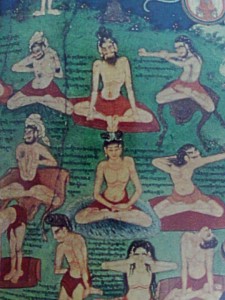
Tibetan Studies, Conference, 2010, Tsering, Shakya
Anuyoga (Skt. अनुयोग ‚further yoga‘) is the designation of the second of the three Inner Tantras according to the ninefold division of practice used by the Nyingma school of Tibetan Buddhism. As with the other yanas, Anuyoga represents both a scriptural division as well as a specific emphasis of both view and practice. Read More: > HERE <
Modern-day doxographical presentations of the Nyingma school are usually based on the system of the nine vehicles (theg pa dgu). Emphasis is placed on the highest three vehicles in this scheme, namely MahÄ�yoga, Anuyoga, and Atiyoga. Generally speaking, these three “inner” yogas correspond to three stages in tantric practice, namely the generation stage, during which the details of the visualizations are stabilized, the perfection stage, in which those visualizations are then employed towards familiarizing oneself with the state of enlightenment, and finally the Great Perfection, the spontaneous accomplishment of buddhahood. Being the second of the three inner yogas, Anuyoga is thus associated with the practices of the perfection stage.
The perfection stage practices are often divided into those without signs (mtshan med) and those with signs (mtshan bcas). The former refer to practices in which the enlightened view is accomplished instantaneously, without any effort, “like a fish leaping out of the water.” The latter – the practices with signs – are generally the perfection stage practices known collectively as “channels and winds” (rtsa lung). Here, the practitioner works with a system of channels within one’s body, through which are moving the “winds” – subtle energies closely related to one’s mind. (Quelle THLIB)
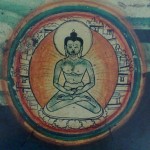
The Nyingma tradition is a complex of many lineages and teachings, including dzogchen. Let us examine some of its major facets.
The Nyingma (Old Translation Period) tradition divides Buddha’s teachings into nine vehicles (theg-pa dgu): three sutra and six tantra. This contrasts with the Sarma (New Translation Period) schools of Kagyu, Sakya, and Gelug, which divide the teachings into three sutra and four tantra vehicles.
- The three sutra vehicles are the shravaka, pratyekabuddha, bodhisattva vehicles. The first two are in the category of Hinayana, while the latter is Mahayana.
- The three outer tantras are kriya, charya, and yoga.
- The three inner tantras are mahayoga, anuyoga, and atiyoga or dzogchen.
- [See: The Terms Hinayana and Mahayana. See also: Basic Features of Tantra.]
The first six vehicles in Nyingma and Sarma are the same. The three Nyingma inner tantra vehicles are roughly equivalent to the Sarma category of anuttarayoga tantra. This is because both categories deal with a subtler level of mental activity (mind) than the lower vehicles do for actualizing the third and fourth noble truths – true stoppings of the first and second noble truths (suffering and its causes) and the true pathways of mind that bring about and have true stoppings. True causes are confusion about reality (unawareness, ignorance) and the fleeting levels of mental activity at which they operate. Because they are fleeting levels, they can be removed.
Maha, Anu, and Atiyoga in Comparison with Father, Mother, and Nondual Anuttarayoga Tantra – Mahayoga, anuyoga, and atiyoga all contain the same basic elements of practice on the tantra path to enlightenment. They differ in terms of emphasis. The same distinction is true concerning the three divisions of anuttarayoga tantra: father, mother, and nondual tantra. The two division schemes, however, are not equivalent.
The practice of anuttarayoga tantra entails the generation stage (bskyed-rim) and the complete stage (rdzogs-rim, completion stage). On the generation stage, we generate ourselves as Buddha-figures merely with the power of our imaginations (visualization). On the complete stage, everything is complete for actually generating the immediate causes for the body and mind of a Buddha – not just in our imaginations.
On the complete stage, we cause the energy-winds (rlung, Skt. prana) to enter, abide, and dissolve in the central channel. This enables us to access the subtlest level of mental activity (clear light, ‘ od-gsal) and use it for the nonconceptual cognition of voidness – the immediate cause for the omniscient mind of a Buddha. We use the subtlest level of energy-wind, which supports clear light mental activity, to arise in the form of an illusory body (sgyu-lus) as the immediate cause for the network of form bodies (Skt. rupakaya) of a Buddha.
Within this scheme of anuttarayoga tantra:
- father tantra emphasizes illusory body practice,
- mother tantra emphasizes clear light practice,
- nondual tantra emphasizes the unified pair (zung-’jug) of illusory body and clear light.
If we use the same scheme as in anuttarayoga to analyze the Nyingma presentation, and divide the complete stage into two phases – before attaining actual clear light nonconceptual cognition of voidness, and after, when we attain the immediate cause for a rupakaya – then:
- mahayoga emphasizes the generation stage,
- anuyoga emphasizes the first phase of the complete stage and working with the energy-winds, channels, and chakras,
- atiyoga (dzogchen) emphasizes the second phase of the complete stage, at which we actualize the immediate causes for the enlightening mind and form bodies of a Buddha.
- READ FULL ARTICLE > HERE <:
RAM NAWAMI IN ‘INDIA’, Prof. Chitralekha Singh
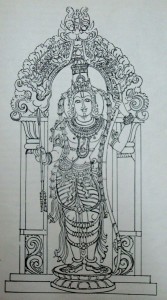
Rama (IAST: rÄ�ma, DevanÄ�garÄ�: राम; Lao: ພຣະຣາມ; Malay: Megat Seri Rama; Tagalog: Rajah Bantugan; Thai: พระราม) or Ramachandra रामचंद्र is the seventh avatar of Vishnu in Hinduism,and a legendary king of Ayodhya in ancient Indian mythology.
Rama is one of the many popular figures and deities in Hinduism, specifically Vaishnavism and Vaishnava religious scriptures in South and Southeast Asia.Most of the details of Rama’s life come from the Ramayana, one of the two great epics of India. Born as the eldest son of Kausalya and Dasharatha, king of Ayodhya, Rama is referred to within Hinduism as Maryada Purushottama, literally the Perfect Man or Lord of Self-Control or Lord of Virtue. Rama is the husband of Sita, whom Hindus consider to be an avatar of Lakshmi and the embodiment of perfect womanhood. Read More: > HERE <
Rama Navami (DevanÄ�garÄ�: राम नवमी) also known as Sri Rama Navami is a Hindu festival, celebrating the birth of Lord Rama to King Dasharatha and Queen Kausalya of Ayodhya. Rama is the 7th incarnation of the Dashavatara of Vishnu. The festival falls in the Shukla Paksha on the Navami, ninth day of the Chaitra month of Hindu calendar. Thus it is also known as Chaitra Masa Suklapaksha Navami, and marks the end of nine-day Chaitra-Navratri celebrations.
In the epic Ramayana, Dasharatha, the Emperor from Ayodhya, had three wives named Kausalya, Sumitra and Kaikeyi in the Treta Yuga, which follows the Satya Yuga and is succeeded by Dwapara Yuga. Their greatest worry was that they had no children, and so they had no heir to the throne in the Ikshvaku Kula or royal lineage of great, pious, wonderful Emperors. Rishi Vasistha suggests him to perform Puthra Kamesti Yagna, through which he can have a desired child.
Among the incarnations of the Supreme Being, that of Rama & Krishna are considered very significant for humanity as it was possible for human beings to relate to him in person. In the Ramavatar (Incarnation of Ram) hsis auspicious qualities were manifest and he set an example to mankind by his adherence to Dharma (Religion). Rama’s matchless prowess as a warrior and his valorus deeds have lent the name ‘Mahavira Vaibhav’. Kalyan Guna (Welfare to humanity) is the main evident of Lord Rama.
It was his Kalyan Guna that he condoned the faults in others even when they had caused harm to him. The most important instance was when Ravana stood helpless without arms in the battlefield it would have been very easy to finish him off if the feeling of revenge on the one who had abducted his wife and kept her under captivity had over ridden, his sence of Dharma in warfare. His propriety and his inborn trait of pardoning others faults came to the tore in this critical juncture. The other Quality which was singular in Rama was his easy accessibility to everyone because of his innate affability (Sausilya). He was not only the supreme being incarnate but also the prince-regent, heir to the emperor of the mighty kingdom of Ayodhya.
Rama endeared himself to one and all by his noble qualities during his exile in the forest, the manner in which Rama addressed Guha, touched by his service by declaring that he was indeed his brother. These are few examples of his holy and piousness.
In Ramayan 16 outstanding qualities of Lord Rama is referred as ‘Krishna’ he performed the very delecate task of proceedings as an envoy of the Pandava’s to explore whether peace could be ensured. In several ways he saved the Pandava’s.
Rama was a prince and as such he could not be assigned the job of an ambassador, however there was an occasion when he admired such a task by another and he felt sorry. He was denied a similar privilege and so in his next manifestation he himself volunteered to do this service. All Gods incarnation are identical in bringing out his concern for those who place their faith in him. Lord descended on the earth protect the pious and thereby revealed his easy accessibility the destruction of wicked men was also his concern but this could have been accomplished by his will.
‘Thyagraja’ the great writter has emphasised that Sri Rama is unique. He said that Rama is ‘Parabrahama’ he is his ‘Ishtadevta’ – He has written many songs in the praise of Lord Rama in ‘Harikambhojit Kirtana’ – He said “Rama is the one and only God. Oh Mind! why do you dissipate?” ‘He is Brahma, Siva, Indra, permanent and the antar yamin in all beings.’
„Hey Ram – Hey Ram“, is a great Devotional prayer sung in the praise of Hindus God Rama. A beautiful bhajan by Jagjit Singh. http://gita-blog.blogspot.com/
Rama is the character who is delighted and grateful even by one act of help by anyone and never entertains in his mind any hostility to one who has done him enormous harm.
Balmiki’s Ramayana is revered as the essence of the vedas itself and ‘Rama’ portrayed as the very passonification of dharma. The purpose of studying scriptured texts like ‘Ramayana’ is to the divine level. One can make his life sublime by a word of comfort to help another in distress. The script of Ramayana desist one from turning proud, when by divines grace one is placed is a high position or is intellectually superior. Ramayana is an epic of Moral values of human being, great source of in spiration to the whole of humanity. India as Ramayana’s birth place is well known and Ramayana has been part and parcel of the Indian way of life from time immemoriel.
Tulsidas has also witten’ Ram Charit Manas’ the history and the great story of ‘Rama’ as an epic which is very popular as it is described in a very simple manner to apporach to the heart of human being-.
Ramnawami is a great day when Rama was born in the Kingdom of Ayodhya King Dashratha & Kaushalya. Today her all incarnation a Shailputri, Brahmacharini, Chaudraghante, Kushmanda, Skandhamata, Katyayni, Kalratri, Mahagauri, Siddhidarti and on the last day on Nawami this year on 23rd March everybody celebrates the birthday of Sri Ram in all its gay mood wearing new clothes, meeting & greeting each other worshipping their Ishta Dev/Devi and congratulates each other.
Article by Prof. Chitralekha Singh
Dean: Institute of Visual, Performing Arts & Research, Mangalayatan University, Beswan, Aligarh.
Visit at: www.artistchitralekha.com
e-mail: chitralekha@artlover.com mob . 91 9319103482
- Ramayana or Ramkatha, NEWS on Festival of Ramkatha <
- Ramayana, Valmiki Ramayana, Adhyatma Ramayana, Tulasi Ramayana- Yogavasistha <
- VEDA, SMRITI, SRUTI on Dharma <
- MORARI BAPU – THE RAMAYANA EPIC POEM <
- Articles „DHARMA“ <
- http://en.wikipedia.org/wiki/Dharma –
- www.ramayoga.net
- Meet Morari Bapu, friends, studies, fans at fb <
- Meet Hinduism, studies, friends, fans at fb <
- According to the various Indian religions, such as Hinduism, Buddhism, Jainism, and Sikhism, beings that live in accordance with Dharma proceed more quickly toward dharma yukam, moksha or nirvana (personal liberation). The antonym of dharma is adharma meaning unnatural or immoral.
Isralestinian Ghandis – Meditation for Peace

www.mkgandhi.org , „My Life is my Message“
Oasis of Peace- (ne-vé shal-om / waah-at i-sal-aam: Hebrew and Arabic for Oasis of Peace [Isaiah 32:18]) A village, jointly established by Jewish and Palestinian Arab citizens of Israel, that is engaged in educational work for peace, equality and understanding between the two peoples.
Israel (Hebrew: יÖ�שÖ�ׂרÖ�אÖ�ל, Yisra’el; Arabic: إِسْرَائِيلُ, IsrÄ�’Ä�l) officially the State of Israel (Hebrew: About this sound מÖ�דÖ�ינÖ�ת יÖ�שÖ�ׂרÖ�אÖ�ל (help·info), Medinat Yisra’el; Arabic: دَوْلَةُ إِسْرَائِيلَ, Dawlat IsrÄ�’Ä�l), is a country in Western Asia located on the eastern shore of the Mediterranean Sea. It borders Lebanon in the north, Syria in the northeast, Jordan in the east, and Egypt on the southwest, and contains geographically diverse features within its relatively small area. Read More: >HERE <
The survival of the State of Israel is precarious – If we don’t change our position toward Palestinian People with more love and compassion, we are headed for our own destruction. This is the reason why we must act before it’s too late. In fact, aside from us, there are many organizations for peace, however, there is an urgent need to make a union amongst all of us, so we can become united and be stronger. This is why I created „The Isralestinian Gandhi’s“. Looking for all pacifists, Israelis and Palestinians, willing to act together and make a drastic change in our society. Not based on the government’s policy of war and bloodshed, but to live together in peace, harmony, love and non-violence. Forgetting about the past and start a new life. Abolishing borders and living in one country, one people. The two brothers children of the same father Abraham.
To make these changes, we must have a voice in the Israeli and Palestinian parliaments, and for this, we need to be part of these parliaments. „The Israeli Gandhi’s“ and „The Palestinian Gandhi’s“, under the umbrella of „The Isralestinian Gandhi’s“ will be the new political parties that will make the difference in the Israeli and Palestinian society. A „geniocratic party“, led by people with greater intelligence (higher IQ), who are able to make the difference and lead accordingly. And not by pathetic politicians who now lead our „mediocratic“ governments.

We are honored to invite you to our first „Meditation for Peace“ in Israel.
It will be held on April 16 at 11:00 AM in Neve Shalom/Wahat al-Salam (http://nswas.org/)
It is time the two brothers, isRaelis and Palestinians/ Jews and Muslims, Children of the same father Abraham will meditate together in peace, harmony and brotherhood. Rising their level of consciousness, hoping for a better life, in a better country. sharing love, peace and brotherhood.
You are most welcome to attend.
The success of this event will depend on your presence.
Fraternally yours
Leon Mellul
www.isralestinian-gandhis.org
„The Message from Water“ Emoto Peace Project

www.internationalwaterforlifefoundation.org
Masaru Emoto (江本勝, Emoto Masaru, born July 22, 1943) is a Japanese author and scientist known for his claim that if human speech or thoughts are directed at water droplets before they are frozen, images of the resulting water crystals will be beautiful or ugly depending upon whether the words or thoughts were positive or negative. Emoto claims this can be achieved through prayer, music or by attaching written words to a container of water. Read More: > HERE <
Lake Biwa (琵琶湖, Biwa-ko?), formerly known as Ōmi (淡海?) Lake, is the largest freshwater lake in Japan, located in Shiga Prefecture (west-central Honshū), northeast of the former capital city of Kyoto. Because of its proximity to the ancient capital, references to Lake Biwa appear frequently in Japanese literature, particularly in poetry and in historical accounts of battles. Read More: > HERE <
Masaru Emoto was born in Yokohama in July 1943. He is a graduate of the Yokohama Municipal University’s department of humanities and sciences with a focus on International Relations. In 1986 he established the IHM Corporation in Tokyo. In October of 1992 he received certification from the Open International University as a Doctor of Alternative Medicine. Subsequently he was introduced to the concept of micro cluster water in the US and Magnetic Resonance Analysis technology. The quest thus began to discover the mystery of water.
He undertook extensive research of water around the planet not so much as a scientific researcher but more from the perspective of an original thinker. At length he realized that it was in the frozen crystal form that water showed us its true nature through. He has gained worldwide acclaim through his groundbreaking research and discovery that water is deeply connected to our individual and collective consciousness
He is the author of the best-selling books Messages from Water, The Hidden Messages in Water, and The True Power of Water. He is a long-time advocate for peace in relation to water. He is currently the head of the I.H.M.General Research Institute and President Emeritus of the International Water for Life Foundation, a Not for Profit Organization.
The research of Dr. Masaru Emoto captures frozen water crystals in photographs that present a glimpse into the mysterious response of water to thoughts, words and pictures. As part of the United Nation’s International Decade for Action: Water for Life, Dr. Emoto wishes to share his discoveries about the responsive nature of water with children around the world. Beginning in 2006, „The Message of Water“ children’s book , will be provided to all the children in the world at no cost within the decade. This effort is called the “Emoto Peace Project.”
Dr. Emoto and many of his readers believe that water holds the potential to create peace on earth. Dr. Emoto and many of his readers believe by holding the intention of peace towards water ― by thinking, speaking and acting with the intention of peace toward water ― water can and will bring peace to our bodies and to the world.
The Emoto Peace Project presents „The Message from Water“ children’s book in hopes that this book will play a leading roll in bring peace to the world.
One man cannot change the world but one man can deliver the message to change the world. We believe it is „The Message from Water“. We thank you very much for your support to Emoto Peace Project.
What is Emoto Peace Project? – With the picture book for children “The Message from Water”, we would like to share a clue to realize world peace that we learned through the research on water in an enjoyable way. We are giving this book to the children around the world for free and hope that they find the importance of water and the true nature of us human beings. This effort is called “Emoto Peace Project”.
The target is children, because we suppose it is rather difficult to change the mind of adults whose opinion is already fixed, and the future is up to the open-minded children. What we adults can do now is to give them a chance to learn about the water or the true nature of us human being. We hope this book will be translated into many languages and be of help to realize the goal.
By the way, > NADA means sound/ NADA YOGAH < , river and flow, and BRAHMA means origin and essence in Sanskrit language. My name is EMOTO: E means river, and MOTO means origin in Japanese language. So, EMOTO is NADA BRAHMAN, which means “the origin of a river” and “the essence is sound/vibration”. The name “Emoto Peace Project” implies our hope that each child who has learned the importance of water and the true nature of us human beings will be a drop and soon turn into a big river for peace.
We would like you to help our project move forward.
Thank you very much.
Masaru Emoto
- NADA YOGA AND PHILOSPHY <
- Meet Masaru Emoto, studies, friends, fans at fb <
- Climate Change – Inuit, Indogenous People on frontline <
- Meet Survival International, friends at fb <
- Meet 100 Million Voices for a Real Climate Deal in Mexico 2010 at fb <
Celebrate the World Day for Water 2010
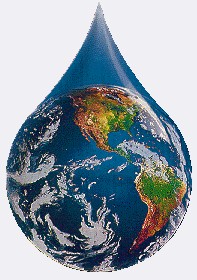
> HOME a film by Yann Arthus-Bertrand <
> UMWELTBERATUNG Wien – Trinkwasser sparen <
In 1993 the United Nations General Assembly declared March 22 as World Day for Water (also known as World Water Day). This day was first formally proposed in Agenda 21 of the 1992 United Nations Conference on Environment and Development (UNCED) in Rio de Janeiro, Brazil. Observance began in 1993 and has grown significantly ever since.Read More: > HERE <
World Water Day is an international day of observance and action to draw attention to the plight of the more than 1 billion people world wide that lack access to clean, safe drinking water. Celebrated since 1993, World Water Day was designated in 1992 when the United Nations (UN) General Assembly passed a resolution. With each passing year, the observance has grown larger and stronger.
In many ways though, World Water Day is still a relatively unknown event. Even with the support of the UN and efforts by leading non-governmental organizations (NGOs) and committed individuals, World Water Day is today at a similar stage as Earth Day was in the early 1970’s – important but relatively unknown.
Beginning in 2005 this began to change. Ethos Water and leading NGOs began an effort to bring even greater attention to the world water crisis on World Water Day. Then in 2006 with the strong backing of the Starbucks Coffee Company and other leading corporate and non-profit allies, we began a major effort to establish March 22 as a day where everyone, regardless of their involvement in water issues, pauses to reflect on the impact of the world water crisis and takes small but meaningful ACTION to make a difference.
In 2009, the theme for World Water Day is „Shared Water – Shared Opportunities“. This year on World Water Day, we will call attention to the waters that cross borders and link us together. Special focus will be placed on transboundary waters. Nurturing the opportunities for cooperation in transboundary water management can help build mutual respect, understanding and trust among countries and promote peace, security and sustainable economic growth. The United Nations Educational, Scientific and Cultural Organization (UNESCO) leads the activities of the World Water Day 2009 with the support of United Nations Economic Commission for Europe (UNECE) and the Food and Agriculture Organization of the United Nations (FAO).
You can help. Sign up to participate in a live event, and / or the Virtual Walk for Water – a strong, symbolic act to demonstrate your support for Action on the world water crisis. We hope you’ll help spread the word and take a moment to lend your voice to this important issue. Join us. Get involved today.
Save Ganga, Yamuna, Mother Earth <
YANTRA – VEDIC SACRED GEOMETRY <
Meet World Water Day, friends, fans at fb <
Meet Say NO to bottled Water, friends, studies at fb <
Meet Plastic Planet, Werner Boote, friends, studies at fb <
Celebrate World Water Day, March 22nd <
Global Kirtan for the Yamuna River <
Meet Save Yamuna to save Vrindavan at fb <
Meet Save Ganga Movement, friends, fans at fb <
G.K. GOSH – WATER OF INDIA: BOOK ONLINE: > HERE <
Meet Gopikanta Ghosh, friends, fans at facebook < I AM A GRADUATE IN CHEMICAL ENGINEERING. SERVED HINDUSTAN LEVER LTD., INDO – BURMA PETROLEUM CO. LTD., ETC., AND FINALLY KHADI & VILLAGE INDUSTRIES COMMISSION RETIRED AS JOINT CEO. AUTHORED MORE THAN 50 BOOKS OUT OF WHICH 48 ARE PUBLISHED.
Vedanta, Quantum Physics & Erwin Schrödinger
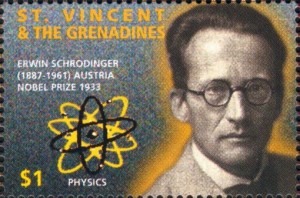
> Nobel Price: Erwin Schrödinger <
> Hinduism & Quantum Physics <
> E. Schrödinger: Are their Quantum Jumps ? <
The basic oneness of the universe is not only the central characteristic of the mystical experience, but is also one of the most important revelations of modern physics.“The most important discovery in the history of science“ -Prof.Henry Stapp, Quantum physicist.
Quantum mechanics (QM) is a set of scientific principles describing the known behavior of energy and matter that predominate at the atomic and subatomic scales. QM gets its name from the notion of a quantum, and that quantum value is the Planck constant. The wave–particle duality of energy and matter at the atomic scale provides a unified view of the behavior of particles such as photons and electrons. The notion of the photon as a quantum of light energy is commonly understood as a particle of light that has an energy value governed by the Planck constant. However, what is quantized is the angular momentum an electron can have as it is bound in an atomic orbital. When not bound to an atom, an electron’s energy is no longer quantized, but it displays, like any other massive particle, a Compton wavelength. While a photon does not have mass, it does have linear momentum. The full significance of the Planck constant is expressed in physics through the abstract mathematical notion of action. Read More: > HERE <
Erwin Rudolf Josef Alexander Schrödinger (German pronunciation: [ˈɛrviːn ˈʃrøːdɪŋɐ]; 12 August 1887, Erdberg – 4 January 1961, Vienna) was an Austrian theoretical physicist who achieved fame for his contributions to quantum mechanics, especially the Schrödinger equation, for which he received the Nobel Prize in 1933. In 1935, after extensive correspondence with personal friend Albert Einstein, he proposed the Schrödinger’s cat thought experiment. Read more: > HERE <
The Rishi’s vision – The > Rishi’s < vision of a world in which man participates in a seamless existence, indivisibly united with the universe around him, resonates through a discovery called > „BELL’S THEOREM“ < . This discovery, first proposed in 1964 by the physicist John S. Bell was first confirmed by experiment in 1972 by Professor John Clauser at Berkley. It is an almost unbelievable result – unbelievable because the logical mind has great difficulty in comprehending how it can be true. Its impact on the physics community has been enormous. Professor Henry Stapp, a physicist at Berkley and an authority on the implications of Bell’s Theorem, has called it. The most important discovery in the history of science.
Erwin Schrödinger is one of the greatest physicists of 20th century was also an enigmatic figure. He was a brilliant scientist, philosopher, poet and a humanist who lead a complex personal life. He was deeply philosophical in his thoughts than any other scientist of his time, but he apparently did not make far-reaching philosophical conclusions from his work in quantum physics. He was held back because he knew there was a lack of clarity. His search for the truth never reached conclusion as his one time lover Hansi Bauer noted.
Erwin’s interest in Vedanta (one of the six schools of Hindu philosophy) and Upanishads started at a young age when he was accustomed to cold and hungry times in war-torn Vienna, but his belief in Vedanta remained the same until his death in 1961: He was a life long believer. Schrödinger was deeply influenced by the thoughts of Schopenhauer, and thus developed strong interest in Buddhist philosophy and Vedanta. He studied the works of Schopenhauer, Henry Warren, Max Welleser, Richard Garbe, Paul Deussen, Max Muller, and Rhys Davids to understand Hindu and Buddhist philosophies.
According to „Vedanta“; there exists only one universal being called the Brahman, which comprises all of reality in an undivided unity. This being absolutely homogeneous in nature: It is pure thought, which is not an attribute but the substance devoid of any qualities. The Brahman is associated with a power or a principle of illusion called Maya. As a magician creates illusion during his act, Brahman through Maya creates the appearances of the material world. Maya is the cause of the material world, and an indivisible Brahman is present in all forms of existence. The soul in reality is an infinite Brahman enmeshed in the unreal world of Maya. The unenlightened soul is incapable of looking beyond this illusion, but an enlightened soul knows the difference between its true self and the external illusory world thus paving the way for identifying itself with Brahman. This unity and continuity concept of All in One expounded in Vedanta is consistent with quantum physics where the universe is superimposed with inseparable waves of probability amplitudes. The Heisenberg uncertainty phenomenon and quantum Zeno effect is an allegory to the illusions of Maya or a prelude to the indivisible, All in One, Supreme Brahman.
In his lectures on relationship of spirit and science, Schrödinger believed that spirit is subjective and can not be subjected to objective examination. He quoted Sañkarâcârya’s commentary, Subject and Object; I and not-I are opposed to each other like light and darkness.
Where Science and Buddhism Meet PART 1, Amit Goswami, Quantum Physics & Consciousness, QUANTUM MECHANICS and THE BIBLE, The Consciousness of the Universe > What the Bleep !? Quantum Physic meets Kabbalah <
Hindu philosophers believed that ego consists of thought in its relation to God, Schrödinger wished to identify ego consisted of thought and the spirit. In a letter to Einstein, he once wrote that he doesn’t believe much in God the father, and Jesus Christ His son, and he lashed out Christian churches accusing them of gross superstition in their belief of individual souls. He continued to believe in the concept one universal being, the Brahman, which comprises all of reality in an undivided unity. Quantum physics has tremendous philosophical implications, which revolutionized modern thought in science and philosophy because it did not agree with the philosophy of materialism expounded by Newton.
Interpretation of quantum world suggested that strict determinism and predictability is not an accurate description of reality, and consciousness is an integral part of the laws of quantum physics. Quantum physical experiments conducted by Alain Aspect (to address Einstein’s EPR experimental results) showed that measurements on correlated pairs follow the quantum mechanical predictions. This result has been found even when the particles are separated by a distance such that even an influence propagated at the speed of light does not affect the result. Thus clearly denying the local realism concept of proposed by Einstein. This simply justifies the principle concept of Vedanta; that is, the reality behind the appearances of physics as an unbreakable whole. If the physical world is real, it is holistic and not merely the sum of separate parts. The wholeness created by the wave particle duality and the indivisible nature of quantum world is in agreement with Vedanta philosophy of unity or Oneness of the Brahman.
Read Full Article at Rama Rao’s Amazon Blog: > HERE < Born and raised in India, and studied and worked in US. My career began as a biochemist and I have published over 60 original research papers in peer reviewed journals in chemistry and biological sciences. I have also published over seven chapters in edited books concerning electron spin resonance spectroscopy and free radical biochemistry. Over several years I developed strong interest in cosmology and astrophysics. I am firmly convinced that nature’s work in terms of its creation of the universe and life may be understood better from quantum cosmology, particle physics, philosophy of physics and universality of consciousness.
- ARTICLES: VEDANTA <
- Ganden Monastery one of the ‚great three‘ university monasteries of Tibet <
- Vishwa Bharati University in India <
- SCHRÖDINGERS BOOKS: Life and Thought
- What Is Life?: with „Mind and Matter“ and „Autobiographical Sketches“
- Mind and Matter.
- In Search of Schrödinger’s Cat: Quantum Physics and Reality
- My View of the World
- Space-Time Structure (Cambridge Science Classics)
- ‚Nature and the Greeks‘ and ‚Science and Humanism‘ (Canto original series)
- The Interpretation of Quantum Mechanics: Dublin Seminars(1949-1955) and Other Unpublished Essays
- Buy Here: http://www.amazon.com/gp/blog/post/PLNK33XJI5G66IAW7
KARNAMRITA DASI: Prayers by Women
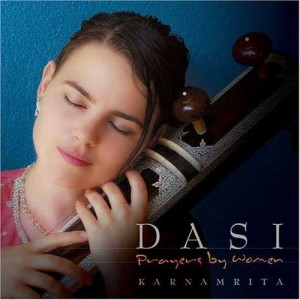
www.lastfm.de/music/Karnamrita
The > BhÄ�gavata PurÄ�ṇa < (DevanÄ�garÄ�: भागवतपुराण) (also known as ŚrÄ�mad BhÄ�gavatam, or BhÄ�gavata) is one of the „Maha“ Puranic texts of Hindu literature, with its primary focus on bhakti (devotion) to the incarnations of Vishnu, particularly Krishna. The Sanskrit text comprises twelve skandas (cantos or books) and 13,216 verses by one count. The BhÄ�gavata includes many stories well known in Hindu tradition, including the various avatars of Vishnu and the life of Krishna. It was the first Purana to be translated into a European language, with three French translations between 1840 and 1857.
Assigning a date for any Purana is problematical, since they are often developed by generations of storytellers. The Bh�gavata itself, along with Hindu tradition, gives ancient origins for the story, with authorship credited to Veda Vyasa. Read More: > HERE <
Karnamrita dasi is an immensely talented and moving singer who has delighted audiences around the world. She grew up in Ashram community in United States, and has sung bhajans and kirtans since childhood. She continued with musical training in Indian classical vocal in Vrindavan, India, and today she is the first female Western performer to be classically trained in India in this sacred art. Acclaimed as one of the most beautiful voices in the Vaishnava tradition, Karnamrita performs all over the world. In 2004 her album “DASI: Prayers by Women” was released.
This album is an offering to women everywhere, evoking a peaceful, yet powerful essence of femininity and devotion. Their voices, their wisdom, and poetry are felt in these songs: composed in both dance and meditative styles. Compiled as a dedication to women of spiritual voices, this is a compilation of women’s songs from India, sung in Hindi and Sanskrit. The songs reflect the styles of chants, Bhajans and Kirtan. The artist has composed the music and arrangements in dedication to her late mother, Kunti Devi.
„In 1998, as my mother was passing away, she requested me to take my singing seriously and record. Although I had studied Sanskrit and sung bhajans for 28 years, I was apprehensive without proper training.That same year, I took her ashes to India, and searched for a teacher to begin studying the classical Dhrupad style.
My two teachers, Pandit Vidur Malik and Tarun Krsna Das guided me through four years of wondrous meditation and training. As a child in school, my teacher Kutila taught us to chant the women’s prayers from the scriptures. Remembering this, I took the opportunity to search out more women in our Sampradaya ( spiritual lineage) and compose music to their words.
Here then, is my offering to these glorious women. Women who sing, pray and share their life with realizations. For all of us, there is a voice that we can relate to, whether it be Draupadi’s song of letting go or simply the Arati celebration to the river Yamuna. Please sing along and let these women touch your heart.“
„mumucur munayo devah sumanamsi mudanvitah mandam mandam jaladhara jagarjur anusagaram nisithe tama-udbhute jayamane janardane devakyam deva-rupinyam vishnuh sarva-guha-sayah avirasid yatha pracyam disindur iva pushkalah“
„The demigods and great saintly persons showered flowers in a joyous mood, and clouds gathered in the sky and very mildly thundered, making sounds like those of the ocean’s waves. Then the Supreme Personality of Godhead, Vishnu, who is situated in the core of everyone’s heart, appeared from the heart of Devaki in the dense darkness of night, like the full moon rising on the eastern horizon, because Devaki was of the same category as Sri Krishna.“ – Srimad Bhagavatam, Canto 10, Chapter 3 „The Birth of Lord Krishna“, Verses 7-8
Product Description – This album is an offering to women everywhere. Their voices, their wisdom, and peace is evoked in a powerful way. Done as a decication to women of spiritual voices, this is a compelation of women’s songs from India. Composed in Hindi and Sanskrit, the album follow the styles of chants, bhajans and kirtan. The songs evoke a peaceful, yet powerful essence of femininity and devotion. The artists has composed the music and arrangements in dedication to her late mother: Kunti Devi.
- SRIMAD BHAGAVATAM ARTICLES <
- Interview: Dhrupad in Musictherapy <
- Meet Karnamrita Dasi, friends, fans at fb <
- Meet Global Peace Initiative of Women, friends at fb <
- Meet Nobel Women´s Inititative, friends at fb <
Monasteries Environmental Himalayaprotection
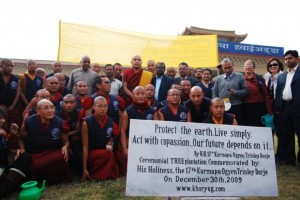
> MYSTIC TRAILS – Clean up Project <
KHORYUG is a network of Buddhist monasteries and centers in the Himalayas working together on environmental protection of the Himalayan region with the aim of practically applying the values of compassion and interdependence towards the Earth and all living beings that dwell here. As Buddhist practitioners, we believe that our actions must flow from our aspiration to benefit all sentient beings and safeguard our mother Earth and that this positive change in our societies must begin with ourselves first.
KHORYUG aims to develop a partnership with community based organizations and NGOs wherever there is a member monastery or center so that together with our communities, we can help and protect all life on Earth now and for the future. Subscribe to get updates on the progress of KHORYUG, and to learn more about how you can help.
KHORYUG IN ACTION! – On the afternoon of Christmas Day, over 150 members of Khoryug met at the front of the gates of Tergar Monastery to clean up the surrounding area, including the roads, ditches, wetlands and lake nearby. Participating in the clean up were monks and nuns of all the Khoryug monasteries as well as visitors from far away who are in Bodh Gaya for the 27th Kagyu Monlam.
The activity was used as an opportunity by Khoryug coordinators to explain the important of minimizing one’s own footprint due to the immense long term impact of non-organic waste such as plastics.
SOLAR PROJECT – This is to bring to your kind notice that Environment Conservation Committee, Rumtek Monastery is going to convey Tashi Delek to all the Dharma Centre and all the Monasteries on the auspicious occasions of Tibetan New Year (Losar) which is on coming 14th. Here, our Environment Committee has already started the home made solar water heating system project to save the energy and reduce the utilization of electricity power and other energies. It has been completed two solar water heating system out of five. Under guidance of one Dharma friend, helping from Sangha Jinpa Gyatso and Environment staff Mr Yeshi, helper Laxman. Our people are expertise in making the solar water heating system by themselves. Currently, our Sanghas are using the hot water for bathing and washing. And also it wills soon utilizing in our main kitchen for cooking, making tea and washing dishes or utensils.
Khenchen Lama, AWAM Foundation, Khampas
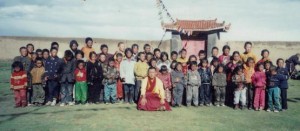
> Heart of Enlightment Institute <
www.upaya.org Zen Center Santa Fe, NM
http://khenchenlama.blogspot.com/
AWAM is a Sanskrit word for compassion coupled with wisdom. AWAM Foundation is a non-profit organization incorporated in the state of Arizona, established to provide support to an orphanage and elder center initiated by Khenchen Lama Rinpoche in eastern Tibet. The activities of the AWAM Foundation are guided by compassion and wisdom and aim to manifest and propagate these deepest values. The foundation aims to engage in fundraising projects that would provide basic needs, housing, medical care and education for the orphans and elders. Importantly, AWAM Foundation focuses on long-term projects directed towards future self-sufficiency of the orphanage and elder center. In our activities, we respect, encourage, and support the traditional Tibetan values. The foundation is governed by three volunteer board members following the guidance of Khenchen Lama Rinpoche. Please consider supporting the worthy activities of AWAM Foundation.
Kham (Tibetan: ཁམས; Wylie transliteration: Khams; Simplified Chinese: 康巴; Pinyin: KÄ�ngbÄ�), is a region presently divided between the Chinese provinces of the Tibetan Autonomous Region, and Sichuan where Khampas, a subgroup within the Tibetan ethnicity, live. Read More: > HERE <
In 1999, Khenchen Lama Rinpoche established an orphanage and a shelter for older people near Jewo monastery in Tibetan province Kham. At that point there were 30 children and 10 older people who did not have any family or government support to provide for them. Moved by their suffering, Khenchen Rinpoche decided to launch a project that would provide the basic needs of food and shelter for the orphans and elders and help them cultivate wisdom and compassion that would guide them to a better future. Arrangements were made for the children to receive basic general education, training in Tibetan and Chinese languages, as well as meditation. In addition, elders interested in meditation received practice instructions from Rinpoche and were supported in their desire to engage in deep meditation practice. Over the last nine years the orphanage and shelter for older people grew in size. Currently, there are 150 children, seven to eighteen years old, and 30 older people between sixty and eighty years of age. While the progress of children and elders in their study and meditation practice is encouraging, there is increasing need to provide for them. In response to Khenchen Rinpoche’s request and under his spiritual guidance, Rinpoche’s students in Arizona established the AWAM Foundation.
HEALTH CLINIC: Because of the secluded location of the orphanage and the elder center, access to medical care is very difficult. The closest hospital that can provide appropriate care is one-day drive from the orphanage. There is a great need for a small hospital, since swift access to medical care is a necessity for small children in the orphanage as well as the elderly. The health clinic would also serve lay Tibetans who inhabit the surrounding areas in proximity of the orphanage. The clinic is planned to include both treatments in traditional Tibetan medicine and Western medicine.
www.upaya.org Pilgrimage Through Kham: A Medical Mission in Tibet
DHARMA TARA YAK FARM – In an effort to make the orphanage and elder center more sustainable, Rinpoche and his students developed a project aimed at providing long-term food contribution to the orphanage through an orphanage-owned yak farm. The Dharma Tara Yak Farm is managed free of charge by a local businessman in Tibet and is providing the orphans and elders with dairy products – the main part of diet in Tibet. Yaks purchased for the orphanage and elder center will never be killed for meat. Between 50-70 yaks are needed to provide for the 180 orphans and elders. Any excess dairy products will be in the future sold for purchase of other food articles for the orphanage. Khenchen Rinpoche is very hopeful about this project because it will provide for the orphans and elders as well as help sustain the traditional way of care for yaks. With recent changes in Tibet, increasing numbers of yaks are being raised for meat and slaughtered in a cruel way.
To launch the project, one of Khenchen Rinpoche’s students donated funds for the first 15 yaks in May 2008. Funds for additional 5 yaks were donated by Rinpoche’s Chinese students. Most recently, Rinpoche’s students from the Dharmakirti College in the USA made a donation for purchase of additional 5 yaks. The herd has currently 32 yaks because 7 baby yaks have been born since May 2008 and this number will grow every year (see picture below). We are very grateful to those who contributed to this project so far! Thanks to your support the start of the project has been a great success!
EDUCATION – When Khenchen Lama Rinpoche started the orphanage, one of the main priorities was to make sure that orphans receive the best education available in the area. To this aim, arrangements were made to cover the basic educational needs for the orphanage. Currently, there are four teachers: 2 monks from a near monastery and 2 local teachers. The curriculum focuses on reading and writing in Tibetan language, Tibetan history and culture, basic algebra, and Chinese language.
Yoga & Buddhism: Similarities & Differences
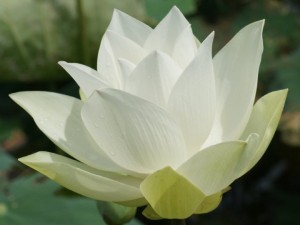
> TYS – Hindu, Buddhist, Jaina Yoga <
Yoga (Sanskrit, PÄ�li: योग yóga) refers to traditional physical and mental disciplines originating in India. The word is associated with meditative practices in Hinduism, Buddhism and Jainism. In Hinduism, it also refers to one of the six orthodox (Ä�stika) schools of Hindu philosophy, and to the goal toward which that school directs its practices. In Jainism it refers to the sum total of all activities—mental, verbal and physical.
Major branches of yoga in Hindu philosophy include Raja Yoga, Karma Yoga, Jnana Yoga, Bhakti Yoga, and Hatha Yoga.Raja Yoga, compiled in the Yoga Sutras of Patanjali, and known simply as yoga in the context of Hindu philosophy, is part of the Samkhya tradition. Many other Hindu texts discuss aspects of yoga, including Upanishads, the Bhagavad Gita, the Hatha Yoga Pradipika, the Shiva Samhita and various Tantras. Read More: > HERE <
Yoga and Buddhism: Similarities and Differences
Written by Dr. David Frawley
Yoga and Buddhism are sister traditions which evolved in the same spiritual culture of ancient India. They use many of the same terms and follow many of the same principles and practices. For this reason it is not surprising that many of us born in the West, particularly after an initial exposure, are apt to regard Yoga and Buddhist teachings as almost identical.
We may want to combine their teachings or practices accordingly, as if there were no real differences between them. The differences that have existed between the two systems historically, which have kept them apart as separate traditions, are less obvious to us in the West than are their commonalities. Or those who study one of these traditions may be inclined to see the other as a borrowing from it. Those who study Buddhism may find so much similarity in Yoga that they suspect a strong Buddhist influence on Yoga. Those who study Yoga may find so much similarity in Buddhism that they see a strong yogic influence on Buddhism.
However, the tendency to find commonality between these two great spiritual traditions is not limited to the West. Swami Vivekananda, the first great figure to bring Yoga to the West, examined the Buddhist Mahayana scriptures (Sutras) and found their key teachings and those of Vedanta that he followed to be ultimately in harmony. In recent years with the influx of Tibetan refugees into India, including the Dalai Lama, there has been a new dialogue between the two traditions that is bringing about greater respect between them. Tibetan Buddhists often appear at Hindu religious gatherings and partake in all manner of discussions.
Nor is the attempt to connect the two traditions limited to modern times. Various synthetic Hindu-Buddhist teachings have existed through history. Buddha himself was born a Hindu and some scholars have argued that Buddhism as a religion apart from Hinduism did not arise until long after the Buddha had passed away. A Shiva-Buddha teaching existed in Indonesia in medieval times, and for many Tantric Yogis it is difficult to tell whether they were Hindus or Buddhists. Buddha became accepted as an avatar of Vishnu for the Hindus during the medieval period, and most Hindus still consider that we live in the age of the Buddha-avatar. Most Hindus accept Buddha as a great teacher, even if they do not accept all Buddhist teachings. Full Article: > HERE <
- Meet Buddhism studies, groups, friends, at fb <
- Meet Hinduism studies, groups, friends, at fb <
- Meet Jainism studies, friends, fans, at fb <
- Meet Dr. David Frawley, AIVS, studies, friends, at fb <
- Meet Traditional Yoga Studies, friends at fb <
Samsara Films, Kumbh Mela, Prims of light

Samsara (Sanskrit: संसार) is the cycle of birth, death and rebirth (i.e. reincarnation) within Buddhism, Bön, Hinduism, Jainism, Sikhism, Vaishnavism and other Indian religions. Colloquially, „Samsara“ can also refer to a general state of overt or subtle sufferings that occur in day to day life.The concept of samsara (along with karma, reincarnation, and moksha) was likely first developed in India by non-Aryan people outside of the caste system. The spiritual ideas of these people greatly influenced later Indian religious thought. Buddhism and Jainism are continuations of this tradition, and the early Upanishadic movement was influenced by it. Reincarnation was adopted from this religious culture by Brahmin orthodoxy, and Brahmins first wrote down scriptures containing these ideas in the early Upanishads. The Sanskrit word „Samsara“ is the root for the Malay word „sengsara“, which means suffering. Read More: > HERE <
Every year, approximately two million people go to India on spiritual quests.
What are they searching for?
In the East, they are called Seekers. In the West, they are labelled „Spiritual Junkies“. Aged anywhere between 16 and 80, they roam in search of personal and spiritual understanding, often without the support of their loved ones or community.
‚Prisms of Light‘ explores this growing phenomenon by focusing on people who are travelling through India on spiritual quests. Interwoven between them are a plethora of spiritual traditions, colourful characters, and chance encounters.
In 2009, Director Yolanda Barker and crew funded a research trip to India, where they shot the promo above. Over the last few months, we have been raising funds to go into production. But we need to get back to India in April for a major spiritual gathering. Time is running out.
„Peace of Mind from a Buddhist Perspective. Samsara“
http://prismsoflightdocumentary.blogspot.com/
Samsara Films has formed a collaboration with Seattle based Typecast Films to make South Asian documentaries, shorts and narrative features available in the North American market. Typecast Films is an emerging film distribution company formed in 2005 by John Sinno, the CEO of Arab Film Distribution (AFD), in order to represent a wider range of cinematic works from around the world. Since its inception, Typecast Films has successfully launched a number of theatrical and DVD releases, including „Iraq In Fragments,“ which won three top prizes at Sundance and was nominated for the 2006 Best Documentary Academy Award.
Samsara Films’ extensive experience in South Asia makes us a key collaborator for projects in India. Our contacts and resources will deliver the highest quality value in production services.
- KUMBH MELA: Songs of the River (60 Min)
- Largest gathering of humanity on Earth!
- www.kumbhmelafilm.com
The Kumbh Mela is a great roving Hindu spiritual festival that has moved around India for more than four thousand years, erecting temporary cities along the Ganges River. The January 2001 Kumbh Mela was the largest gathering of humanity in recorded history. East joined West, ancient met future at the advent of the 21st Century. Millions of people came from all over the globe to pray for peace and rebirth for themselves and for the world. Appearing: HH Dalai Lama, Dr. Andrew Weil, Yogmata Keiko Aikawa, Pilot Baba, Kaali Baba.
REVIEWS – “It is a fascinating look at our humanity and at how our spirituality manifests in the world.” – Stephen Simon Producer, WHAT DREAMS MAY COME and Co-Founder of Spiritual Cinema Circle
“Songs of the River displaces a Westerner from everyday certitudes and opens him or her to the power of the Kumbha Mela experience and the consciousness people like [Yogmata] Keiko Aikawa seek. All in all, a compelling cinematic experience.“ —
Harold Crooks, whose documentary film credits include the award-winning The World Is Watching, The Champagne Safari and The Corporation.
- ABE OSHEROFF
- “One Foot in the Grave the other Still Dancing” (72 Min)
Most people knew Abe Osheroff as an activist — from the frontlines of the Spanish Civil War to the picket lines of the U.S. labor movement, from the struggles for civil rights in Mississippi to the work for human rights in Nicaragua. For most of his 92 years, Osheroff threw himself into the fray with rare energy and enthusiasm. In this riveting documentary, Osheroff reflects on the meaning of that activism and the ideas that animated his actions. A truly organic intellectual, he shares the wisdom built up over a lifetime of commitment to the „radical humanism“ that defined his politics and philosophy.
- VARANASI SACRED FIRE (50 min)
- www.kmp2001.com
A cinematic meditation on a remarkable city, where both life and death are encountered daily on the great Ganges River. This is a rare account of cremation rituals at Manikarnika Ghat, India’s holiest funeral ground.